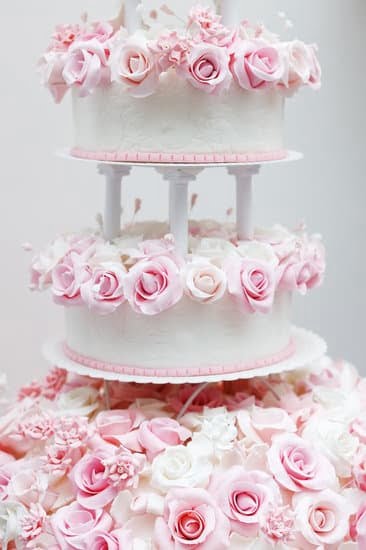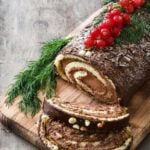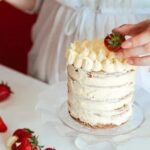Are you looking to learn how to decorate flowers on a cake and elevate your baking skills? Decorating cakes with beautiful floral designs has become increasingly popular, adding a touch of elegance and sophistication to any special occasion.
From weddings to birthdays, flowers can transform an ordinary cake into a stunning centerpiece. In this article, we will guide you through the process of selecting the right flowers, preparing them for decoration, and mastering various techniques for creating breathtaking floral arrangements on cakes.
The art of decorating cakes goes beyond just taste; it is also about creating visually appealing masterpieces that leave a lasting impression. Flowers have long been used as a symbol of beauty and celebration, making them an ideal choice for enhancing cake designs. With the right knowledge and techniques, you can effortlessly elevate your cake decorating skills and impress your friends and family with stunning floral creations.
Before diving into the specifics of flower cake decoration, it is essential to understand the importance of choosing the right flowers and color coordination. The types of flowers you select can greatly impact the overall aesthetic of the cake, so it’s crucial to pick fresh or edible flowers that are safe for consumption and complement the theme or design of the cake.
In the following sections, we will provide comprehensive guidance on how to choose suitable flowers, prepare them properly, and execute various decorating techniques to achieve professional-looking results.
Choosing the Right Flowers
When it comes to decorating cakes with flowers, it is important to choose the right type of flowers that are not only visually appealing but also safe for consumption. Fresh flowers are a popular choice for cake decoration, but it is crucial to ensure that they are free from pesticides and other harmful chemicals. Additionally, edible flowers can be used as a delightful and safe alternative to fresh blooms.
Fresh Flowers
When selecting fresh flowers for cake decoration, it is essential to choose varieties that are non-toxic and safe for consumption. Some examples of popular edible flowers that are commonly used for cake decoration include roses, violets, pansies, calendula, and marigolds. It is important to avoid using flowers from florists or garden centers unless they have been specifically labeled as edible.
Edible Flowers
Using edible flowers is a wonderful way to add a unique and appetizing touch to cake designs. Edible flowers such as lavender, hibiscus, elderflower, and nasturtiums can be used to create stunning floral arrangements on cakes. These blossoms not only provide a delightful visual appeal but also contribute interesting flavors and aromas to the dessert.
Safety Precautions
Before using any type of flower for cake decoration, it is essential to thoroughly research their safety for consumption. Some flowers may cause allergic reactions or other adverse effects if ingested.
Furthermore, it is crucial to confirm that the chosen blooms have not been treated with any chemicals or pesticides that could be harmful when in contact with food. When in doubt about a specific flower’s safety or edibility, consult with a professional florist or culinary expert before using them on a cake.
Preparing the Flowers
To start, carefully remove the pollen from the flowers as it can stain the cake and may cause adverse reactions in some individuals. Gently pluck the stamens or pollen-bearing anthers from the center of each flower using tweezers or your fingers if preferred.
Once the pollen is removed, wash the flowers under cold running water to eliminate any dirt, insects, or pesticides that may be present. It’s important to use a delicate touch when washing to avoid damaging the petals. After washing, let the flowers air dry on a paper towel to remove excess moisture before placing them on the cake.
It’s crucial to ensure that you are only using edible flowers that are free from chemicals and pesticides when decorating a cake. This will guarantee that not only do they look beautiful but they are also safe for consumption by anyone enjoying the cake.
| Preparing Steps | Description |
|---|---|
| Remove Pollen | Gently pluck stamens or anthers from the center of each flower |
| Wash Flowers | Wash the flowers under cold running water gently to eliminate dirt and other contaminants |
| Drying | Lay flowers on a paper towel to air dry and remove excess moisture before using on cakes |
| Edible Flowers Only | Use only edible flowers free from chemicals and pesticides to ensure safety for consumption. |
Decorating Techniques
When it comes to decorating cakes with flowers, there are various techniques that can be utilized to create stunning and visually appealing designs. One popular method is the cascading arrangement, where flowers are arranged in a cascading pattern down the side of the cake, creating an elegant and graceful look. This technique works well for taller tiered cakes and adds a sense of movement to the overall design.
Another option is the clustered arrangement, which involves grouping several flowers together in one area of the cake. This style creates a focal point and can be used to highlight a specific part of the cake, such as the top or a particular tier. By clustering flowers together, it also allows for greater customization and creativity in terms of color coordination and texture.
For a more organic and naturalistic appearance, some decorators opt for scattered arrangements. This method involves placing individual flowers sporadically across the surface of the cake, creating a whimsical and effortlessly charming aesthetic. Scattered arrangements work particularly well for rustic or bohemian-themed cakes, adding a touch of wild beauty to the overall design.
Regardless of the chosen technique, it’s important to ensure that the flowers are arranged in a way that complements the cake’s design and theme. Whether it’s creating a sense of movement with cascading blooms or adding a pop of color with clustered arrangements, each method offers its own unique visual impact. Experimenting with different decorating techniques can allow for endless creative possibilities when it comes to designing floral cakes that are sure to impress any audience.
Tools and Materials
When it comes to decorating a cake with flowers, having the right tools and materials is crucial for achieving a beautiful and professional-looking design. Whether you’re a novice or an experienced baker, having the essential supplies on hand will make the process much smoother. Here’s a list of the must-have tools and materials needed for flower cake decoration:
- Floral Tape: This versatile adhesive is used to attach flowers to wires, stems, or other decorative elements. Floral tape is available in different colors and widths, allowing you to seamlessly blend it with your floral arrangements.
- Scissors: A sharp pair of scissors is necessary for cutting stems, shaping leaves, and trimming flowers to the desired length. It’s important to use clean and well-maintained scissors to prevent damage to the delicate petals.
- Petal Dust: This edible powder adds depth and dimension to your flower decorations by enhancing their color. Petal dust comes in a wide range of shades and can be applied using specialized brushes or cotton swabs.
In addition to these essential items, other useful tools for flower cake decoration include floral wire, floral foam for arranging bouquets or sprays, and food-safe gloves for handling fresh flowers. Investing in quality tools will not only make the decorating process easier but also ensure that your floral cake designs look professional and polished.
Whether you prefer working with fresh blooms or edible flowers made from fondant or gum paste, having these essential supplies at your disposal will set you up for success when adorning your cakes with beautiful botanical accents. With the right tools and materials on hand, you can explore various techniques for incorporating flowers into your cake designs and create stunning confections that are sure to impress any recipient or party guest.
Color Coordination
When it comes to decorating a cake with flowers, one of the most crucial aspects to consider is color coordination. Choosing the right flowers and color schemes can make a significant impact on the overall aesthetics of the cake design. Here are some essential tips for selecting flowers that complement the cake’s design and theme.
Understanding Color Theory
Before selecting flowers for cake decoration, it’s important to have a basic understanding of color theory. Consider the color palette of the cake, including its base color and any additional accents or decorations. Use this as a guide to choose flowers that either match or contrast in a harmonious way.
Complementing the Theme
The theme of the event or celebration where the cake will be presented should also influence your flower selection. For example, if it’s a spring-themed party, opt for pastel-colored flowers like roses, peonies, or lavender. For a more formal occasion, such as a wedding, white or cream-colored blooms like lilies or orchids can create an elegant touch.
Using Contrasting Colors
For those who want to add an element of surprise and visual interest to their floral cake design, consider using contrasting colors. This technique involves selecting flowers that are opposite on the color wheel from the cake’s primary hue. This can create a bold and eye-catching effect when done tastefully.
By carefully considering color coordination when decorating with flowers on a cake, you can elevate its visual appeal and create stunning designs that impress guests and clients. Whether it’s for a birthday, wedding, or other special occasions, these tips will help you achieve an aesthetically pleasing floral cake decoration.
Potential Challenges
When decorating cakes with flowers, it’s essential to be aware of potential challenges that may arise during the process. One common issue is the wilting of fresh flowers. To ensure that your floral cake decorations remain fresh and vibrant, here are some troubleshooting tips to consider:
1. Proper hydration: Ensure that the flowers have been properly hydrated before using them for cake decoration. Submerge the stems in water for a few hours or overnight to rehydrate them, especially if they have been out of water for an extended period.
2. Refrigeration: If you’re not using the flowers immediately, store them in a cool place or refrigerate them to prolong their freshness. However, be cautious when placing them in the refrigerator as some edible flowers may be sensitive to cold temperatures.
3. Mist regularly: To keep flowers looking fresh and prevent wilting, lightly mist them with water before arranging them on the cake. Be mindful not to oversaturate the flowers, as excess moisture can cause issues with the cake’s frosting.
By taking these precautionary measures, you can minimize the risk of wilting and ensure that your floral cake decorations maintain their beauty throughout your event or celebration.
In addition to wilting, another challenge when decorating with flowers is ensuring that they are safe for consumption. It’s crucial to select edible flowers or take appropriate steps to make non-edible blooms safe for use on cakes. Keep reading for more details on how to decorate flowers on cakes while ensuring they are safe for consumption.
Finishing Touches
Adding the finishing touches to a floral cake design can truly elevate the overall aesthetic and create a stunning visual impact. One of the key elements in this stage is incorporating greenery, leaves, and additional embellishments to complement the flowers and complete the look of the cake.
When it comes to adding greenery, it’s essential to select types that are safe for consumption and visually appealing. Popular choices include herbs like rosemary or thyme, as well as decorative foliage such as eucalyptus or ivy. These elements not only provide texture and depth to the design but also contribute to a cohesive and natural look.
In addition to greenery, including leaves can further enhance the beauty of floral cake decorations. Delicate leaves can be strategically placed around the flowers to create a sense of movement and flow. When choosing leaves, ensure they are thoroughly cleaned and free from any pesticides or chemicals prior to use on the cake.
Furthermore, incorporating additional embellishments like edible pearls, delicate sugar butterflies, or metallic accents can add a touch of elegance and sophistication to the overall design. These details can serve as eye-catching focal points and contribute to a beautifully adorned cake.
With careful consideration and thoughtful placement of greenery, leaves, and other embellishments, decorators can achieve a visually stunning floral cake that is sure to impress any audience. The finishing touches play a crucial role in bringing together all elements of the design and creating a show-stopping centerpiece for any occasion.
Conclusion
In conclusion, learning how to decorate flowers on cakes can elevate your baking skills and bring a touch of elegance to your creations. By choosing the right flowers, preparing them correctly, and utilizing various decorating techniques, you can achieve stunning floral cake designs that are not only visually appealing but also safe for consumption.
The use of tools and materials like floral tape, scissors, and petal dust will aid in the successful application of flowers on cakes, while color coordination and addressing potential challenges will ensure a harmonious and flawless result.
As you embark on your journey of creating floral cake designs, remember that practice makes perfect. Experiment with different flower arrangements and color schemes to find what works best for your individual style and the theme of the occasion.
Don’t be afraid to get creative with finishing touches such as greenery or additional embellishments to truly make your floral cake designs stand out. With dedication and patience, you’ll soon be able to master the art of decorating flowers on cakes and impress your friends and family with your exquisite confections.
In closing, let this guide inspire you to unleash your creativity and express yourself through the beauty of floral cake decorations. Whether it’s for a special celebration or just to showcase your artistic talent, incorporating flowers into your cake designs will undoubtedly leave a lasting impression. So go ahead, gather your tools, select some lovely blooms, and start creating your own stunning floral cake masterpieces.
Frequently Asked Questions
How to Decorate Flowers on a Cake?
Decorating a cake with flowers can add a beautiful and elegant touch to any special occasion. To decorate flowers on a cake, it’s important to first ensure that the flowers are clean and free from pesticides. You can gently place the flowers on top of the cake or arrange them in a pattern around the edges.
Can You Stick Flowers Directly Into a Cake?
While it may be visually appealing to stick flowers directly into a cake, it’s not advisable to do so. This is because many flowers are treated with chemicals and pesticides that are not safe for consumption.
Instead, it’s best to use a barrier between the flowers and the cake, such as a food-safe holder or individual stems wrapped in floral tape.
Is It Safe to Put Fresh Flowers on a Cake?
It is generally not safe to put fresh flowers directly onto a cake without taking proper precautions. Many florists treat their flowers with chemicals and pesticides that can be toxic if ingested. If you want to use fresh flowers on a cake, it’s crucial to ensure they are organic or have been specifically grown for culinary purposes.
Additionally, creating a barrier between the flowers and the cake will help prevent any contamination. Always prioritize food safety when decorating with fresh flowers on a cake.

Welcome to our cake decorating blog! My name is Destiny Flores, and I am the proud owner of a cake decorating business named Cake Karma. Our mission is to provide delicious, beautiful cakes for all occasions. We specialize in creating custom cakes that are tailored specifically to each customer’s individual needs and tastes.





